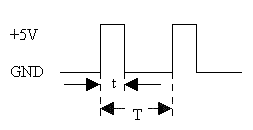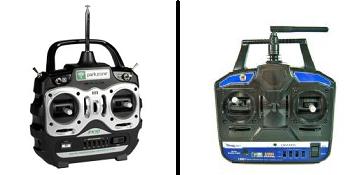The Theory
The theory section will focus on two sides of this tutorial. The first side is what the output signal from the receiver module will look like and the second focus is an overview of how things are working between the transmitter and receiver pair.
Receiver Output - The Servo Signal

t = 0.9 mS to 2.1 mS || T = 19.1 mS to 17.9 mS
The signal output by the receiver module used in this tutorial is meant to be received by a hobby servo. So if we look back to the servo motor control tutorial where we learned how to create these signals, it's pretty obvious what they look like. What might not be immediately obvious is how we can capture and use them.
Since we know what the servo signal looks like (pictured above), what we will have to use inside the PIC is called the Capture module which 'captures' falling or rising edges of input signals. The PIC 18F452 has two Capture modules which is perfect because we want to control two devices. This means we can use the PIC's capture modules combined with a PIC timer to count the difference in PIC instruction cycles between signals if we capture every falling and rising edge. This will give us accurate timing values for each signal which we can use to control the output LED and Motor.
Transmitter To Receiver
The type of transmitter and receiver pair used in this project is an off-the-shelf RC Hobby Transmitter and RC Hobby Receiver. Older RC cars were always controlled by AM or FM radio receivers in the range between 25 and 100 MHz. Newer transmitters and receivers will operate at the 2.4 GHz frequency, however, all radio receivers still output the same servo signal and are compatible with this tutorial.

As an example the pictures above show an older AM/FM transmitter on the left (notice the telescoping antenna) and a newer 2.4 GHz transmitter (short, bent antenna). The newer 2.4 GHz transmitter/receiver pairs are generally better, but the older 75 MHz transmitters still work very well too.
The theory section will focus on two sides of this tutorial. The first side is what the output signal from the receiver module will look like and the second focus is an overview of how things are working between the transmitter and receiver pair.

t = 0.9 mS to 2.1 mS || T = 19.1 mS to 17.9 mS
The signal output by the receiver module used in this tutorial is meant to be received by a hobby servo. So if we look back to the servo motor control tutorial where we learned how to create these signals, it's pretty obvious what they look like. What might not be immediately obvious is how we can capture and use them.
Since we know what the servo signal looks like (pictured above), what we will have to use inside the PIC is called the Capture module which 'captures' falling or rising edges of input signals. The PIC 18F452 has two Capture modules which is perfect because we want to control two devices. This means we can use the PIC's capture modules combined with a PIC timer to count the difference in PIC instruction cycles between signals if we capture every falling and rising edge. This will give us accurate timing values for each signal which we can use to control the output LED and Motor.
The type of transmitter and receiver pair used in this project is an off-the-shelf RC Hobby Transmitter and RC Hobby Receiver. Older RC cars were always controlled by AM or FM radio receivers in the range between 25 and 100 MHz. Newer transmitters and receivers will operate at the 2.4 GHz frequency, however, all radio receivers still output the same servo signal and are compatible with this tutorial.

As an example the pictures above show an older AM/FM transmitter on the left (notice the telescoping antenna) and a newer 2.4 GHz transmitter (short, bent antenna). The newer 2.4 GHz transmitter/receiver pairs are generally better, but the older 75 MHz transmitters still work very well too.